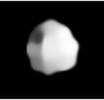18 Melpomene
 | |
| Discovery | |
|---|---|
| Discovered by | John Russell Hind |
| Discovery date | June 24, 1852 |
| Designations | |
MPC designation | (18) Melpomene |
| Pronunciation | /mɛlˈpɒmɪniː/[1] |
Named after | Melpomenē |
Minor planet category | Main belt |
| Adjectives | Melpomenean /mɛlpɒmɪˈniːən/[2] |
| Orbital characteristics[3] | |
| Epoch October 22, 2004 (JD 2453300.5) | |
| Aphelion | 418.414 Gm (2.797 AU) |
| Perihelion | 268.472 Gm (1.795 AU) |
| 343.443 Gm (2.296 AU) | |
| Eccentricity | 0.218 |
| 1270.552 d (3.48 a) | |
| 205.245° | |
| Inclination | 10.126° |
| 150.547° | |
| 227.975° | |
| Physical characteristics | |
| Dimensions | c/a = 0.81±0.06[4] 170 × 155 × 129 km[5] (150×125 km)[6] (150×170 km)[7] |
Mean diameter | 141±2 km[4] 140.6±2.8 km (IRAS)[3] |
| Mass | (4.5±0.9)×1018 kg[4] 3.0×1018 kg[5] |
Mean density | 3.06±0.62 g/cm3[4] 1.69±0.66 g/cm3[5] |
| 0.482 21 d (11.57 h)[3][8] | |
| 0.221 (calculated)[4] 0.223[3][9] | |
| S[3] | |
| 7.5[10] to 12.0 | |
Absolute magnitude (H) | 6.51[3] |
| 0.23" to 0.059" | |
Melpomene (minor planet designation: 18 Melpomene) is a large, bright main-belt asteroid that was discovered by J. R. Hind on June 24, 1852,[11] and named after Melpomenē, the Muse of tragedy in Greek mythology. It is classified as an S-type asteroid and is composed of silicates and metals.
Melpomene occulted the star SAO 114159 on December 11, 1978. A possible Melpomenean satellite with a diameter at least 37 km was detected. The satellite candidate received a provisional designation S/1978 (18) 1.[12] In 1988 a search for satellites or dust orbiting this asteroid was performed using the UH88 telescope at the Mauna Kea Observatories, but the effort came up empty.[13] Melpomene was observed with the Hubble Space Telescope in 1993. It was able to resolve the asteroid's slightly elongated shape, but no satellites were detected.[6]
Melpomene has been studied by radar.[14]
References[]
- ^ Noah Webster (1884) A Practical Dictionary of the English Language
- ^ E.g. Tim Shephard (2014) Echoing Helicon
- ^ a b c d e f Yeomans, Donald K., "18 Melpomene", JPL Small-Body Database Browser, NASA Jet Propulsion Laboratory, retrieved 7 April 2013.
- ^ a b c d e P. Vernazza et al. (2021) VLT/SPHERE imaging survey of the largest main-belt asteroids: Final results and synthesis. Astronomy & Astrophysics 54, A56
- ^ a b c Jim Baer (2008). "Recent Asteroid Mass Determinations". Personal Website. Archived from the original on 8 July 2013. Retrieved 27 November 2008.
- ^ a b Storrs, Alex; Weiss; Zellner; Burlsen; et al. (1999). "Imaging Observations of Asteroids with Hubble Space Telescope" (PDF). Icarus. 137 (2): 260–268. Bibcode:1999Icar..137..260S. doi:10.1006/icar.1999.6047. Archived from the original (PDF) on 30 October 2008. Retrieved 3 November 2008.
- ^ Storrs, Alex; Dunne; Conan; Mugnier; et al. (2005). "A closer look at main belt asteroids 1: WF/PC images" (PDF). Icarus. 173 (2): 409–416. Bibcode:2005Icar..173..409S. doi:10.1016/j.icarus.2004.08.007. Archived from the original (PDF) on 10 March 2012. Retrieved 26 November 2008.
- ^ "Lightcurves and Map Data on Numbered Asteroids N° 1 TO 52225". AstroSurf. Archived from the original on 27 November 2005. Retrieved 3 November 2008.
- ^ "Asteroid Data Archive". Planetary Science Institute. Archived from the original on 23 June 2006. Retrieved 3 November 2008.
- ^ Menzel, Donald H.; Pasachoff, Jay M. (1983). A Field Guide to the Stars and Planets (2nd ed.). Boston, MA: Houghton Mifflin. p. 391. ISBN 0-395-34835-8.
- ^ "Numbered Minor Planets 1–5000", Discovery Circumstances, IAU Minor Planet center, retrieved 7 April 2013.
- ^ IAUC 3315: 1978 (18) 1; WZ Sge, Central Bureau for Astronomical Telegrams, retrieved 5 July 2011.
- ^ Gradie, J.; Flynn, L. (March 1988), "A Search for Satellites and Dust Belts Around Asteroids: Negative Results", Abstracts of the Lunar and Planetary Science Conference, 19, pp. 405–406, Bibcode:1988LPI....19..405G.
- ^ Radar-Detected Asteroids and Comets, NASA/JPL Asteroid Radar Research, retrieved 30 October 2011.
External links[]
- 18 Melpomene at AstDyS-2, Asteroids—Dynamic Site
- 18 Melpomene at the JPL Small-Body Database

- Minor planet object articles (numbered)
- Background asteroids
- Discoveries by John Russell Hind
- Minor planets named from Greek mythology
- Named minor planets
- S-type asteroids (Tholen)
- S-type asteroids (SMASS)
- Astronomical objects discovered in 1852